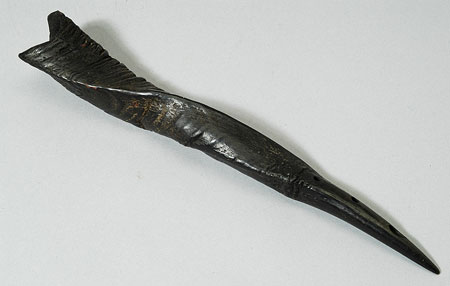Accession Number:
1940.7.0228
Country:
Sudan
Date Made:
By 1940
Materials:
Animal Horn , Resin Plant
Process:
Carved , Hollowed , Perforated
Dimensions:
L = 285, embouchure diam ext. = 39 by 32.1, diam int. = 24 by 28; finger-hole diam = 4 (top 2 holes) and 12 by 5 mm lowest hole); length from lowest finger-hole to horn tip = 25 mm [RTS 7/3/2005].
Weight:
83.3 g
Other Owners:
Samuel P. Powell
Field Collector:
Samuel P. Powell
PRM Source:
Samuel P. Powell
Acquired:
Loaned 1940
Collected Date:
By 1940
Description:
Notched end-blown flute carved from the end of an animal's horn, currently a dark brownish black colour (Pantone black 7C).
This has been hollowed out, and consists of an embouchure with concavely-cut front and back edges, one deeper than the other and both with signs of wear, with the mouth rising up at the sides to produce a lentoid plan view.
Two wads of a dark brown resinous material have been added to these raised areas inside the mouth, as a means of modifying the width of the aperture.
Below the embouchure the body tapers and twists spirally, following the natural shape of the horn, which continues down to a sharp point at the distal end.
Three finger-holes have been cut into its lower part.
The upper two holes are circular; the lower hole has been cut at an angle, producing an elongated oval opening; the body is solid below this point to the horn tip.
The object is complete and intact; there are a few small patches of red ochre smeared somewhat randomly on the surface; this could be from contact with other objects in storage.
The flute has a weight of 83.3 grams.
Its body is 285 mm long, with an embouchure that measures 39 by 32.1 across its outer edges, and has an internal diameter of 24 by 28 mm across.
The upper and second finger-holes have diameters of 4 mm, while the third finger-hole measures 12 by 5 mm across, and is positioned 25 mm from the horn tip.
This object was collected by Samuel P. Powell, and loaned to the Pitt Rivers Museum in 1940.
This flute is said to have been used for hunting. Similar instruments, made from various type of animal horn including waterbuck, bushbuck and antelope, are found amongst the Lango (1925.14.14-16 and 1934.8.96), and Baka (1930.86.58). See also M. Trowell & K.P. Wachsmann, 1953, Tribal Crafts of Uganda, pl. 81A, where the type is called a 'cone flute'. The tribe has not been specified in this instance.
Rachael Sparks 14/9/2005.
This object was collected by Samuel P. Powell, and loaned to the Pitt Rivers Museum in 1940.
This flute is said to have been used for hunting. Similar instruments, made from various type of animal horn including waterbuck, bushbuck and antelope, are found amongst the Lango (1925.14.14-16 and 1934.8.96), and Baka (1930.86.58). See also M. Trowell & K.P. Wachsmann, 1953, Tribal Crafts of Uganda, pl. 81A, where the type is called a 'cone flute'. The tribe has not been specified in this instance.
Rachael Sparks 14/9/2005.
Primary Documentation:
Accession Book Entry
[Loans II, p.
308] - ESTATE OF S.P.
POWELL, C/O N.H.
HASLAM, Esq.
Manager, Westminster Bank, Stony Stratford, Bucks.
Collected by himself.
Data from his labels and notes.
[p.
321] 1940.7.0228 - Black hunting horn.
Tribe not given.
(ref.
later).
Added Accession Book Entry [page opposite 321, pencil] - Listed but not labelled.
Card Catalogue Entry - SUDAN? V~Black hunting horn.
Card Catalogue Entry [tribes] - There is no further information on the catalogue card [RTS 28/1/2004].
Related Documents File - Appears on undated typed list: "One black hunting horn - refer tribe later (?)". List is annotated by hand on back: "List of Curios" and "Far from complete" [RTS 16/12/2003].
Pitt Rivers Museum label - Black [insert] hunting [end insert] horn. Tribe [insert] ? pierced ?musical instrument [crossed out] on list - no data [end insert]. Reference to notes later? S.P. Powell [brown luggage label, tied to object; RTS 7/3/2005].
Added Accession Book Entry [page opposite 321, pencil] - Listed but not labelled.
Card Catalogue Entry - SUDAN? V~Black hunting horn.
Card Catalogue Entry [tribes] - There is no further information on the catalogue card [RTS 28/1/2004].
Related Documents File - Appears on undated typed list: "One black hunting horn - refer tribe later (?)". List is annotated by hand on back: "List of Curios" and "Far from complete" [RTS 16/12/2003].
Pitt Rivers Museum label - Black [insert] hunting [end insert] horn. Tribe [insert] ? pierced ?musical instrument [crossed out] on list - no data [end insert]. Reference to notes later? S.P. Powell [brown luggage label, tied to object; RTS 7/3/2005].




